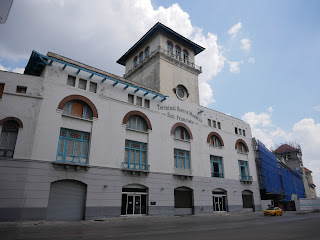One of the hallmarks of a Road Scholar trip is their emphasis on scholar. They pride themselves on using a combination of teaching methods including lectures, walking tours, and group activities so we can be immersed in the culture and learn more.
Saturday morning's lecture on music became Sunday morning's lecture. Professor Alberto Faya, an energetic 80-year old singer, musician, researcher, and university professor, covered the history of Cuban music from 1511 to present day in one hour.
As a group we walked through the Prada to the bus waiting for us just around the corner.
During our short bus ride to San Francisco Square we learned about the education system in Cuba. Though vastly different from what we are used to in the United States, it reminded me of things I have learned about the French, Belgian, and German education systems. You are pigeonholed at a young age making it hard to take a different path.
Around the age of 9 children are eligible to participate in specialized schools such as ones for ballet, dance, music, and sports. If you enroll in one of those schools you stay there until grade 12 when you have to pass aptitude tests in Spanish, history and math before continuing your education. If you want to go into a scientific field you also have to pass tests in physics, biology, and chemistry.
You can leave school after 9th grade, but there are very few opportunities available.
The government projects how many people will be needed in every field. Your score ranks you. The top scores get to continue in the field of their choice. Lower scores have to change the course. Journalism, math, and computers are examples of very competitive career paths.
Let's say you want to change your career. You need a score of at least 4.5/5 to consider it. If there is availability, changes can be made in the second year of university.
Cubans developed three effective vaccines. According to a report by Harvard University, had others followed their vaccine model, many lives would have been saved. Not only did they create their own vaccine, they vaccinated most of their citizens.
San Francisco Square is also known as pigeon square. For this leg of the trip, Lian asked her friend to keep an eye on us. Deaf and mute, he made sure we were not bothered by beggars, and made sure we did not get lost. He gave Lian a second set of eyes.

The Franciscans were in Cuba from the 16th to the 19th century. After that the convents were secularized. At one point this lovely building was converted into a fire station. Another point it was the chamber of commerce for Havana. Now it is an office building.
Rub the statue in front of the church for good luck. Though I got into the proper position (one hand on the bard, the other on his hand, and stepping on his foot) I was too distracted posing for a picture that I didn't make a wish. A lost opportunity! The last time I followed a tradition I wished for a new job and had one within a week of returning home. I really could use some international luck!
We were set free for lunch in this square. Lian gave us some instructions: if the menu is not in US Dollars, ask the conversion rate before you sit down. Tell them you have to be out of there by 2:15. She pointed out a few places (including an ice cream shop!) and we were off.
We looked at a couple of places with cousins Wendy and Ruth. When they sent us upstairs to the room we were in the same room as a table of 10 from our group. We decided for a smaller meal than usual -- no appetizers or dessert. When the bill arrived, we had the option of paying in US Dollars, Euros, or CUP. I actually debated because I had the euros and it seemed like a really good rate.
Of course Don and I saved room for ice cream! The serving size was small, the cup enormous! They only charged us $2 for three scoops, so we tipped an extra dollar for the experience. As a bonus, I met a French-speaking family so I was able to converse in a language that feels more familiar.
We were ready for more adventures. Our next stop was to a warehouse full of craft vendors. Everything was painfully cheap. We were offered 12 magnets for $5. I bought a pair of earrings for $4. A true entrepreneur could swoop through there and fill a suitcase for under $50. Later we learned one woman paid a local $5 to show her the best places to buy certain souvenirs. She left with a Che Guerra t-shirt, musical instruments, a dress for her daughter, and other souvenirs ... things we didn't even notice on our swoop. There must have been at least 100 vendors, all asking us to buy things from them. I bought a couple of magnets and a pair of earrings and went out side to take pictures of old cars. Don went in a different direction and took bicycle pictures.




























No comments:
Post a Comment